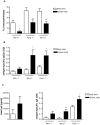Prevention of birch pollen-related food allergy by mucosal treatment with multi-allergen-chimers in mice
- PMID: 22768077
- PMCID: PMC3387141
- DOI: 10.1371/journal.pone.0039409
Prevention of birch pollen-related food allergy by mucosal treatment with multi-allergen-chimers in mice
Abstract
Background: Among birch pollen allergic patients up to 70% develop allergic reactions to Bet v 1-homologue food allergens such as Api g 1 (celery) or Dau c 1 (carrot), termed as birch pollen-related food allergy. In most cases, specific immunotherapy with birch pollen extracts does not reduce allergic symptoms to the homologue food allergens. We therefore genetically engineered a multi-allergen chimer and tested if mucosal treatment with this construct could represent a novel approach for prevention of birch pollen-related food allergy.
Methodology: BALB/c mice were poly-sensitized with a mixture of Bet v 1, Api g 1 and Dau c 1 followed by a sublingual challenge with carrot, celery and birch pollen extracts. For prevention of allergy sensitization an allergen chimer composed of immunodominant T cell epitopes of Api g 1 and Dau c 1 linked to the whole Bet v 1 allergen, was intranasally applied prior to sensitization.
Results: Intranasal pretreatment with the allergen chimer led to significantly decreased antigen-specific IgE-dependent β-hexosaminidase release, but enhanced allergen-specific IgG2a and IgA antibodies. Accordingly, IL-4 levels in spleen cell cultures and IL-5 levels in restimulated spleen and cervical lymph node cell cultures were markedly reduced, while IFN-γ levels were increased. Immunomodulation was associated with increased IL-10, TGF-β and Foxp3 mRNA levels in NALT and Foxp3 in oral mucosal tissues. Treatment with anti-TGF-β, anti-IL10R or anti-CD25 antibodies abrogated the suppression of allergic responses induced by the chimer.
Conclusion: Our results indicate that mucosal application of the allergen chimer led to decreased Th2 immune responses against Bet v 1 and its homologue food allergens Api g 1 and Dau c 1 by regulatory and Th1-biased immune responses. These data suggest that mucosal treatment with a multi-allergen vaccine could be a promising treatment strategy to prevent birch pollen-related food allergy.
Conflict of interest statement
Figures








Similar articles
-
Intranasal treatment with a recombinant hypoallergenic derivative of the major birch pollen allergen Bet v 1 prevents allergic sensitization and airway inflammation in mice.Int Arch Allergy Immunol. 2001 Sep;126(1):68-77. doi: 10.1159/000049496. Int Arch Allergy Immunol. 2001. PMID: 11641608
-
A recombinant allergen chimer as novel mucosal vaccine candidate for prevention of multi-sensitivities.Allergy. 2007 Jan;62(1):33-41. doi: 10.1111/j.1398-9995.2006.01245.x. Allergy. 2007. PMID: 17156339
-
Suppression of antigen-specific T- and B-cell responses by intranasal or oral administration of recombinant bet v 1, the major birch pollen allergen, in a murine model of type I allergy.J Allergy Clin Immunol. 1999 Jun;103(6):1202-10. doi: 10.1016/s0091-6749(99)70200-9. J Allergy Clin Immunol. 1999. PMID: 10359907
-
Recombinant allergens for allergen-specific immunotherapy: 10 years anniversary of immunotherapy with recombinant allergens.Allergy. 2011 Jun;66(6):775-83. doi: 10.1111/j.1398-9995.2011.02565.x. Epub 2011 Feb 26. Allergy. 2011. PMID: 21352238 Review.
-
Current State of Celery Allergy: Is Discovering Api g 7 a Milestone in Diagnosing Celeriac-Allergic Patients?Int J Mol Sci. 2025 Jun 18;26(12):5840. doi: 10.3390/ijms26125840. Int J Mol Sci. 2025. PMID: 40565300 Free PMC article. Review.
Cited by
-
Machine Learning-Empowered FTIR Spectroscopy Serum Analysis Stratifies Healthy, Allergic, and SIT-Treated Mice and Humans.Biomolecules. 2020 Jul 16;10(7):1058. doi: 10.3390/biom10071058. Biomolecules. 2020. PMID: 32708591 Free PMC article.
-
Murine models for mucosal tolerance in allergy.Semin Immunol. 2017 Apr;30:12-27. doi: 10.1016/j.smim.2017.07.007. Epub 2017 Aug 12. Semin Immunol. 2017. PMID: 28807539 Free PMC article. Review.
-
Analysis of Protein Sequence Identity, Binding Sites, and 3D Structures Identifies Eight Pollen Species and Ten Fruit Species with High Risk of Cross-Reactive Allergies.Genes (Basel). 2022 Aug 17;13(8):1464. doi: 10.3390/genes13081464. Genes (Basel). 2022. PMID: 36011375 Free PMC article.
References
-
- Bohle B. The impact of pollen-related food allergens on pollen allergy. Allergy. 2007;62:3–10. - PubMed
-
- Bucher X, Pichler WJ, Dahinden CA, Helbling A. Effect of tree pollen specific, subcutaneous immunotherapy on the oral allergy syndrome to apple and hazelnut. Allergy. 2004;59:1272–1276. - PubMed
-
- Hoffmann-Sommergruber K. Plant allergens and pathogenesis-related proteins. What do they have in common? Int Arch Allergy Immunol. 2000;122:155–166. - PubMed
-
- Steinman H. Oral allergy syndrome - whats new? Current Allergy & Clinical Immunology 22. 2009.
-
- Geroldinger-Simic M, Zelniker T, Aberer W, Ebner C, Egger C, et al. Birch pollen-related food allergy: clinical aspects and the role of allergen-specific IgE and IgG4 antibodies. J Allergy Clin Immunol 127: 616–622 e611. 2011. - PubMed
Publication types
MeSH terms
Substances
Grants and funding
LinkOut - more resources
Full Text Sources
Medical
Miscellaneous

